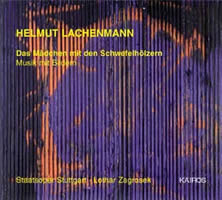Das Mädchen mit den Schwefelhölzern
|
Mike Silverton [May 2004.]
Scattered thoughts about an engaging opera. A disappointment: The corps de ballet, costumed as mid-19th-century Copenhagen merchants, notaries, doctors, attorneys, academics, etc., along with their ladies, all in festive evening clothes, languish in a nearby café: EU work rules. From Lachenmann’s notes:
Having never thought of the composer as other than remarkable — a brilliant, contemplative Klangkünstler, yes; a nihilist, not — I take comfort from Lachenmann’s words. Still, two aspects cause me to wonder. The first and most obvious is the music’s subject. Andersen’s The Little Match Girl (as the story is known in English) is bathetic and maudlin. And the music is anything but — edgy, eerie, creepy, dazzling: purest Lachenmann. One never knows for certain what’s in another’s heart. Perhaps, with Lachenmann, what seems to me a mechanically ironistic, postmodern gambit is something else again. As a tourist having muddled through the modern mostly intact, I feel that I can raise the possibility of irony, or better, ironism, without tripping intruder alarms. In this aesthetically omnidirectional, rarely innovative time, just about everything to do with the creative arts bears the mark of irony, ironic distancing, ironism — and, alas, fatigue. Been there, done that, and doing it again, but differently, maybe. As an old-fashioned modernist, Lachenmann continues to siphon his inspiration from a pool fewer and fewer composers visit. More’s the pity, or maybe not. Which only goes to say that art music has its traditions. In the flavor of its sentiments, The Little Match Girl is very much in the Schubertian-Romantic mold: It is the outsider, literally a figure in the cold, rather than the cozy, indifferent burghers, who engages our attention. (That we do not rush onstage to wrap the perishing waif in our overcoats makes of us — sadistic voyeurs? I would not be the first to observe that sentimentality and cruelty can coexist, dissonance-free, in the same personality.) My other misgiving concerns the libretto. In the quoted statement, Lachenmann appears to disavow new-music-as-protest as ineffectual, shopworn cliché, and amen to that! Yet he includes the words of a German terrorist, Gudrun Ensslin, whom he met when both were children. Again perhaps, he chooses to quote Ensslin because of a coincidence he sees as an omen. And then there are the Andersen bits and a piece of rather intense prose from Leonardo da Vinci’s Codex Arundel, a compilation of the great man’s papers. In the notes an advisory: The libretto “does not follow a traditional narrative pattern.” Fortunately for the listener with little or no German, excepting a few moments of clearly amplified speech, the texts are presented in so stylized and gestural a fashion as to be beyond even a Germanophone’s reach. The synopsis and libretto provide a clear enough picture. However, what one hears does not often correspond with the track-keyed texts. On a personal note, with Lachenmann, one’s interest centers on the composer’s brilliantly complex sounds. However, as a sop to comprehension, in following the libretto, we all the better savor Lachenmann’s evocations of cold, speeding carriages, New Year’s Eve festivities, the child’s isolation, the striking of matches and their attendant hallucinations, an ascent to paradise…. With respect to Ensslin’s words (which I mention as an example of Lachenmann’s effective sleight-of-hand), we see them in full in the libretto, but even here, spelled out as clearly as they are, they appear to begin somewhere within a longer statement. And the vocalization is both scant and unintelligible: no correspondence. But in terms of effect? Had this track accompanied a good horror film, I’d have fled the movie house or at the very least covered my eyes. To dwell on a point, the synchrony of texts to music is largely tangential, and the music is largely gripping. The penultimate track, entitled Shô, at ten minutes the opera’s longest, features Mayumi Miyata (a busy lady, she) in something like pure magic. (The shô is a Japanese mouth organ and a quite beautiful object.) Those moments of little seeming consequence, with their whispers and sighs, imply a need to know what’s happening onstage, and of course we don’t. On the other hand, the sweet-spot occupant is in a better position to reconcile the music’s direction to its words. At least I think so. Or prefer to. Opera — any opera — as a two-channel recording requires an engaged imagination. Would a DVD on a good home-theater system prove the more satisfying? I’m reminded of the radio plays I listened to as a kid. Technically, this is a first-rate production. The composer participated in the mastering process. The two female vocalists, instrumental soloists, instrumental ensemble, chorus and conductor collaborate in what impresses one fan as high-grade Lachenmann. Bravo, Kairos! Postscript: This Kairos set appeared in 2002. In July 2004, ECM will release another Little Match Girl. According to a label spokesman, ECM’s will be the composer-revised, “Tokyo version.” It’s not clear to me whether the Kairos is a recording of a live Stuttgart State Opera performance. An absence of audience and stage noise suggests not. In any event, the ECM release will be a “rigorously controlled and meticulously monitored recording made under studio-like conditions in Freiburg [with] a much clearer sense of the composer’s sensitivity toward the musical materials.” I can’t wait. Elizabeth Keusch, Sarah Leonard, sopranos; Salome Kammer, speaker; Mayumi Miyata, shô; Yukiko Sugawara, Tomoko Hemmi, piano; Staatsopernchor and Staatsorchester Stuttgart, Lothar Zagrosek (cond.). Andreas Priemer, recording supervisor; Gerd Puchelt, sound engineer. Kairos 0012282KAI, two CDs (http://www.kairos-music.com). Distributed in the US by Albany (http://www.uncommonlyclassical.com/). [This review should be read alongside Mike’s Helmut Lachenmann on Kairos from February 2003. W.M.]
[More Mike Silverton]
[More
Lachenmann]
[Previous Article:
Notes of a Working Pianist]
[Next Article:
RetraCE We NeW E CarteR]
|
